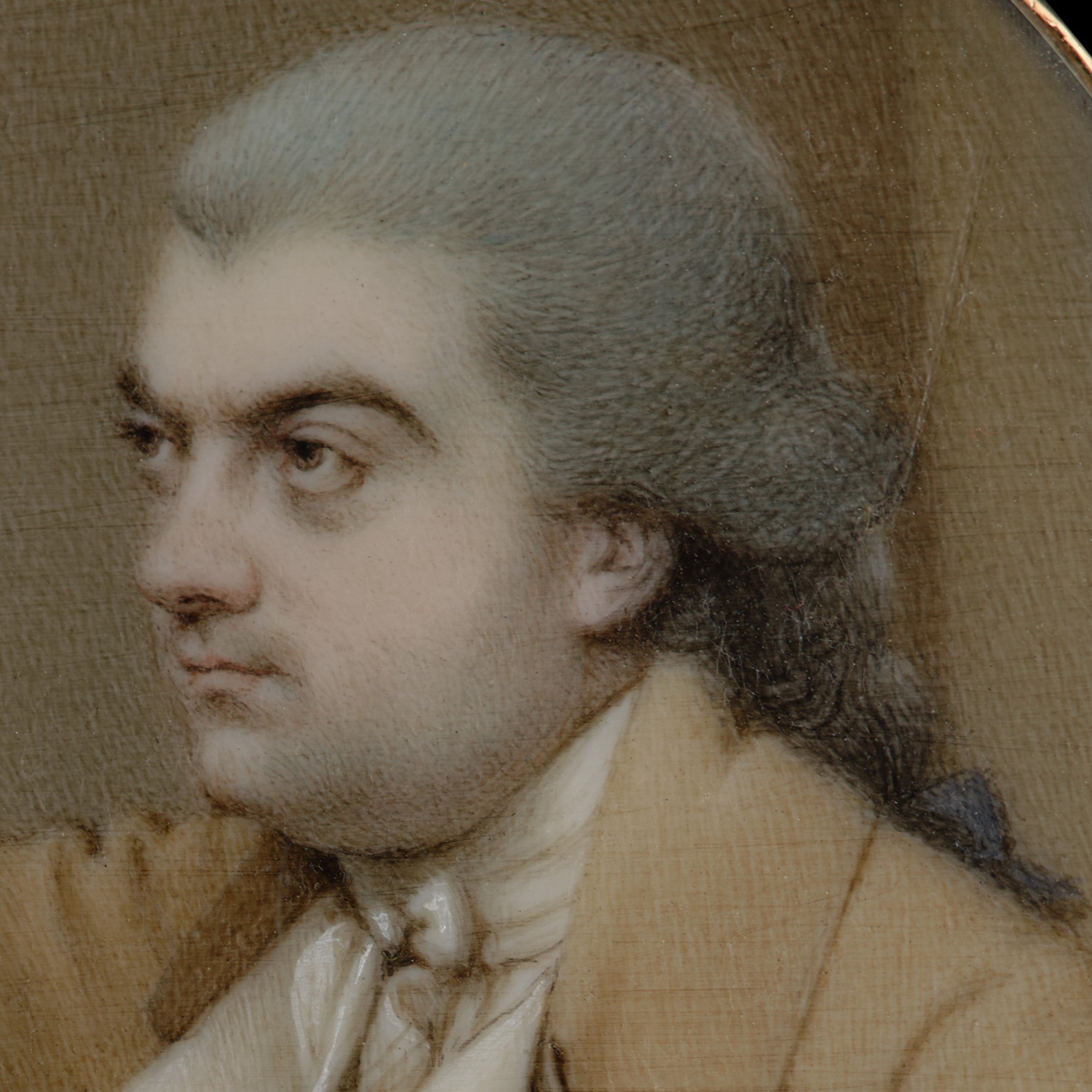JOHN BOGLE (1746-1803)
Portrait miniautre of John Yenn RA (1750-1821), wearing cream coat and waistcoat; dated 1785
Watercolour on ivory
Ivory registration number: NSB6JU1W
Signed and dated ‘Bogle 1785’
Gold frame
Oval, 2 ¾ in. (59 mm) high
Provenance: Sotheby’s, 11th July 1991, lot 256 (sitter unidentified, described as ‘portrait of an architect’); Possibly William Drummond, London; Private Collection, UK.
SOLD
“Yenn was the first architect in Britain to produce architectural drawings for an exhibition rather than for a client…”
John Yenn RA (1750-1821) was an eighteenth-century English architect known for his mannerist style and close relationship to Sir William Chambers (1723 – 1796). Yenn was Chambers’s apprentice from the age of sixteen and followed him to the Royal Academy, becoming a full academician in 1791 and then as Treasurer, succeeding Chambers on his death, from 1796 to 1820. Whilst Yenn is not as widely remembered as his mentor, as evidenced in Howard Colvin’s Biographical Dictionary of English Architects where he was only denoted one page to Chamber’s six, he gained numerous public and royal commissions and positions during his lifetime.
To a great extent much of this contemporary success was owed to Chambers, under whose guidance and training Yenn flourished. It was as Chambers’s ‘ingenious faithful intelligent servant’ that Yenn was able to work for the rest of his professional life, picking up public and private projects and positions such as Clerk of the Works at Richmond Park in 1780 and Surveyor to Greenwich Hospital in 1788.[1] Their close relationship is prominently displayed in John Francis Rigaud’s portrait of Yenn. Depicting the architect looking up from his designs, Rigaud draws attention to Yenn’s great mentor by inclusion of Chambers’s Treatise on Civil Architecture (1759) conveniently to hand on the table next to the sitter (Fig. 1. John Francis Rigaud R.A., Portrait of John Yenn, R.A., (Before 1785). Collection, Royal Academy of Arts, given by Augusta Thackeray, Granddaughter of the architect, in 1865).[2]
However, it would be incorrect to assume that it is was solely down to Chambers’s championing of Yenn that he ascended to membership of the Royal Academy. Critical to election was involvement in the Academy’s annual exhibition, through which the merit of the contributor would be assessed. It was there in 1771 that Yenn was awarded a Gold Medal and asserted his reputation as the first architect in Britain to produce architectural drawings for an exhibition rather than for a client.[3]
This elegant portrait miniature is by John Bogle (1746 – 1803), a Scottish artist who exhibited annually at the Royal Academy between 1772 and 1794. Described by a contemporary as an artist who ‘excelled in small likenesses’, Bogle, like Rigaud, points to the sitter’s profession and reputation through inclusion of a volume of Vitruvius’s De architectura below the architect’s right hand.[4] Yenn appears to have been caught in a moment of scholarly reflection, resting his arm upon the lectern, apparently unaware of the artist’s presence. Such a naturalistic and frank characterisation is commonly seen in Bogle’s most acclaimed miniatures, arguably alluding to a friendship between sitter and artist. It could be presumed that Yenn met Bogle at the Royal Academy, where friendship and professional networking overlapped.
[1] In 1774 Chambers described Yenn as ‘an ingenious faithful intelligent servant’,’ quoted in John Harris introduction to London, Heinz Gallery, John Yenn, draughtsman extraordinary: drawings from the Royal Academy of Arts, 3rd September – 19th October 1973. Yenn succeeded Sir Robert Taylor (1714–1788) when he became Surveyor of Greenwich Hospital.
[2] John Francis Rigaud R.A., Portrait of John Yenn, R.A., Before 1785. Royal Academy of Arts Collection, given by Augusta Thackeray, Granddaughter of the architect, on 21st June 1865.
[3] Exhibition Catalogue, John Yenn R.A. Pioneer of the Architectural Exhibition Drawing, (exhibition catalogue), Royal Academy, London, 9 March – 9 July 2010, P. 2
[4] Vitruvius, a Roman architect, and engineer from the 1st century BC, who originated the idea that all buildings should have three harmonious attributes: strength, utility and beauty. Sotheby’s made no conclusion on identity of the sitter and instead gave the work the title ‘Portrait of an architect’ when sold in July 1991.





